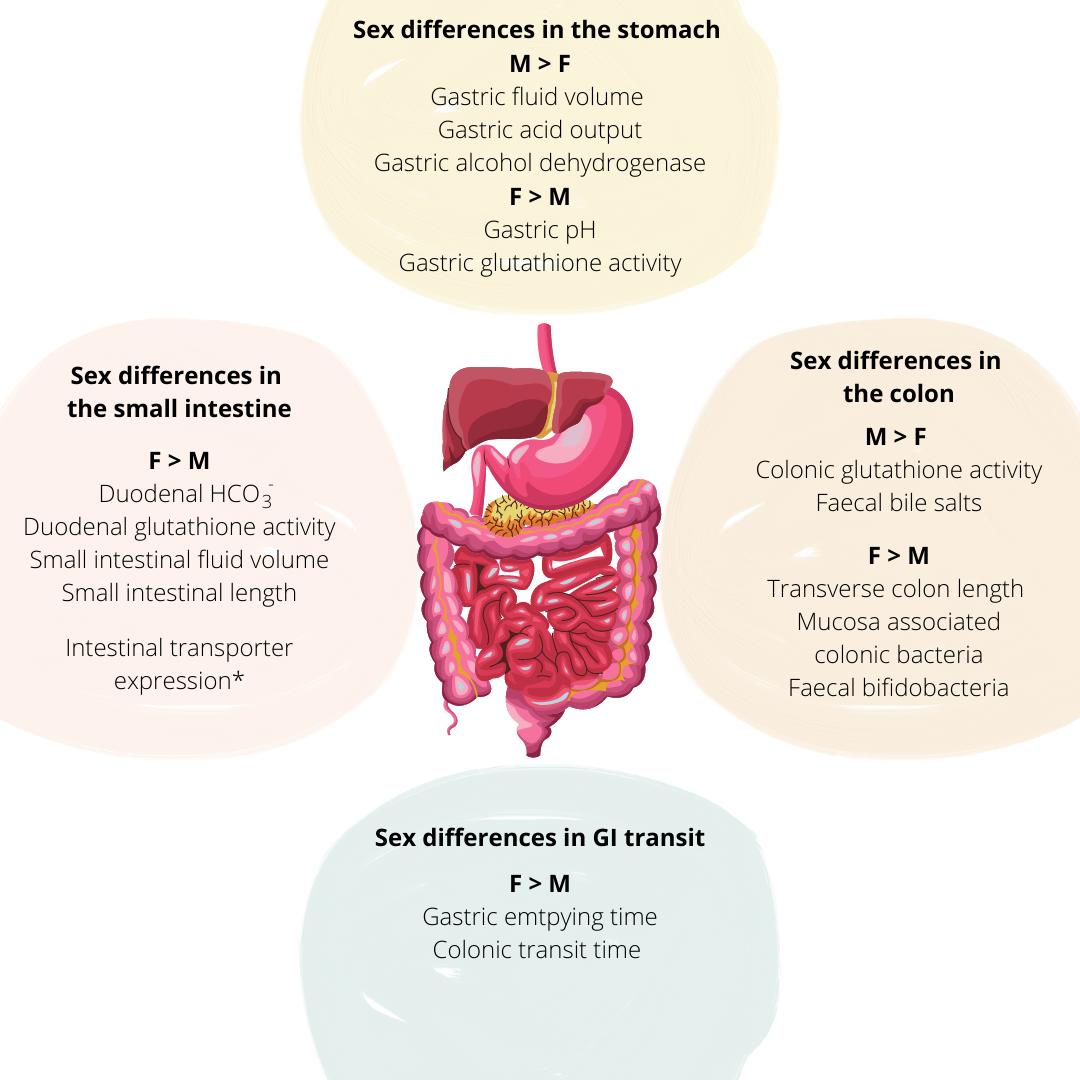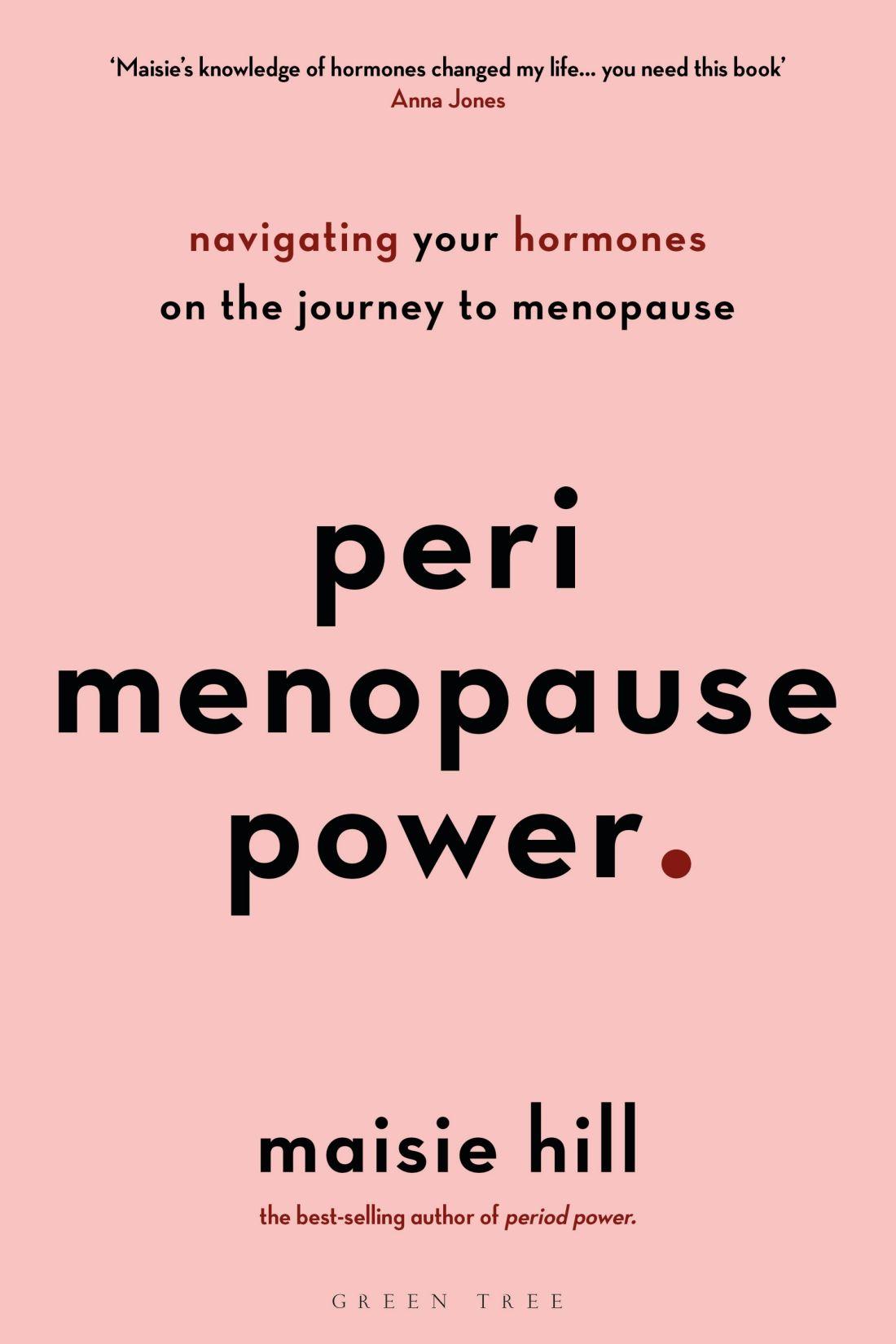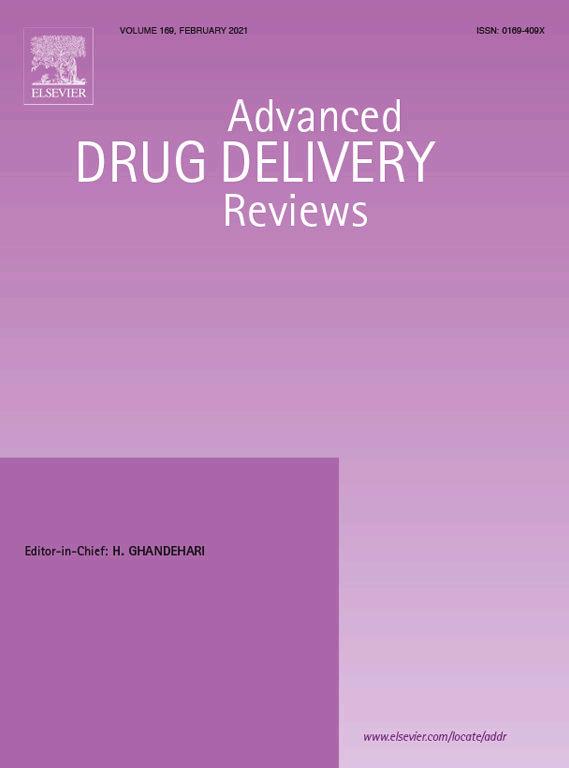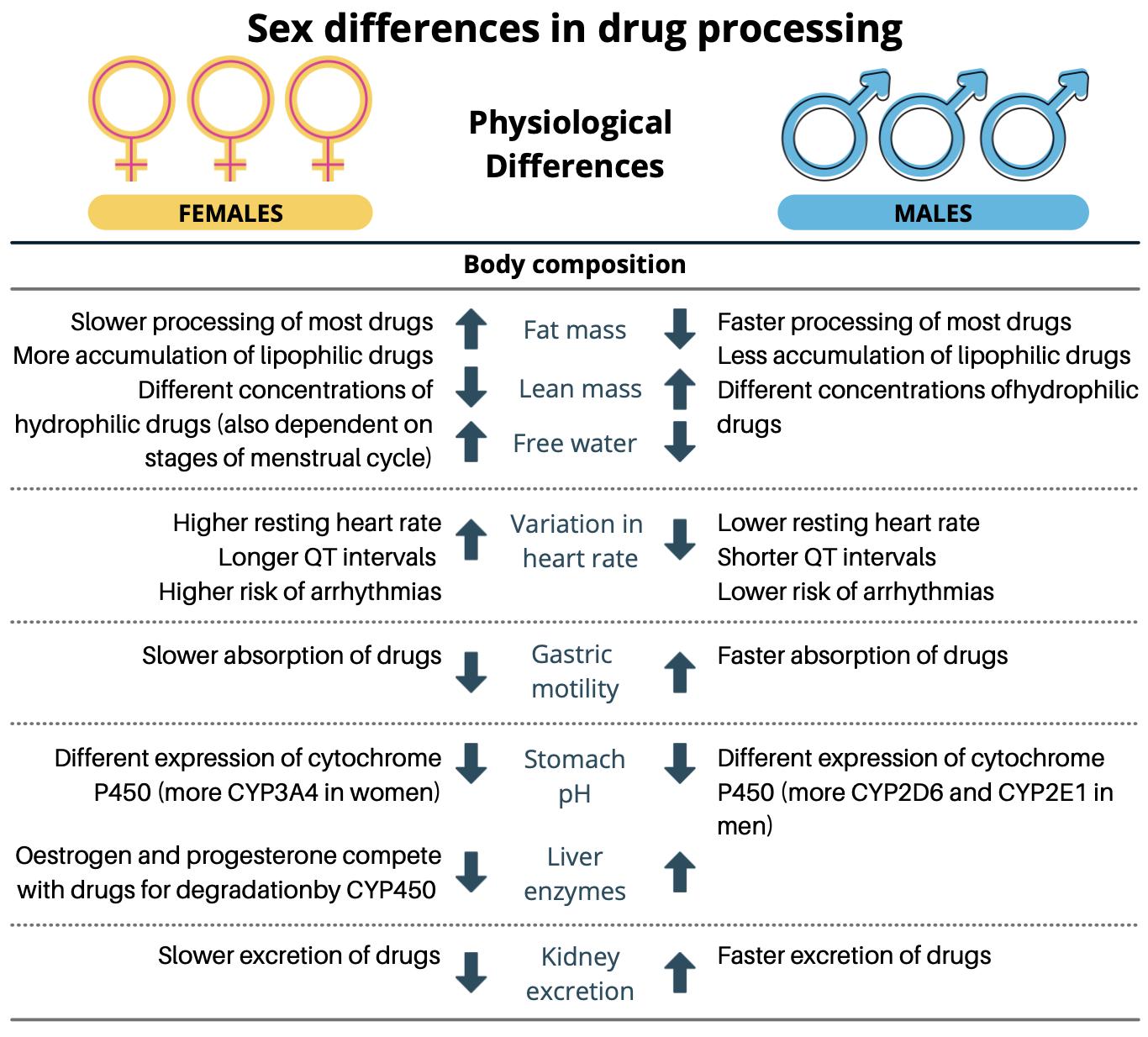1.0 Introduction
In general, women are prescribed more drugs than men, require increased access to health care services but suffer from more adverse drug reactions (ADRs) and are hospitalised more often due to ADRs than men (even when adjusted for age-related differences) [1]. The lack of consideration of potential sex differences exists in nearly all areas of research and development and has seeped into the mainstay of society. For example, research from van Hoof et al. observed that office building thermostats are based on male metabolic rates with temperatures set too low for many women [2]. Some consequences, however, can be life threatening. In engineering, many devices and machines have been designed to fit male bodies; military and commercial cockpits were traditionally based on male anthropometry. As a consequence, it was potentially dangerous for some women or small men to become pilots [3]. Appropriate female representation has vastly been ignored in scientific research including immunology, pharmacology and neuroscience. Interestingly, in the preclinical field of behaviour and reproduction, sex as a biological variable is of particular interest [4].
Our cells are innately infused with sex differences that cannot be ignored. The phrase “every cell has a sex” captures the essence of how fundamentally different men and women are when it comes to health and disease (Figure 1a). In fact, every nucleated cell has a sex containing the sex chromosomes (in its simplest form, XX in females or XY in males [5]). A femalepredominance to chronic disease is seen in epidemiology, pathology, clinical course and diagnosis of Alzheimer’s disease, influenza and pneumonia to name a few (Figure 1b). The onset and development of heart disease, specific cancers and chronic pulmonary disease, however,areleadingcausesofdeathinmen[6].InlightoftheCOVID-19pandemic,theglobal number of confirmed cases, severe symptoms, differing immune response and mortality rate due to the disease are higher among men [7-10] However, recent epidemiology data from the COVID Symptom Study application revealed that women were more likely to develop “long COVID” where symptoms persist for longer than 12 weeks [11].
In biomedical research, women and non-human female mammals have often been underrepresented. Although there is some recognition today of the need for appropriate female representation in clinical trials, in previous decades, the consideration and inclusion of males overshadowed females in clinical research design and conduct. Figure 1c demonstrates a male
bias in articles involving interdisciplinary research including biology, neuroscience, physiology,pharmacologyandbehaviour.Females,however,werethesexofinterestinsubject areas spanning reproduction, endocrinology and behavioural physiology [4]. Although Figure 1c outlines the employment of both sexes, it is clear that results are seldom disaggregated according to sex which can potentially skew or even conceal sex-specific differences in biomedical research (Figure 4) [4]. The leading assumption is that i) results from male studies appropriately apply to females or ii) hormonal cycles decrease the homogeneity of study populations and complicate experimental designs to such an extent that it may not be worth studying females from the outset [4]. In addition, the risk of adverse effects such as teratogenicity outweighed other considerations and thus, females of child-bearing potential were largely excluded from clinical trials [12]. In some cases, little evidence exists for the safety profiles of drugs in pregnant or breastfeeding females, therefore such females and their healthcare professionals are advised to consider the risk-benefit ratio of therapeutic use. The COVID-19 vaccination programme is such an example [13]. In addition, when studying diseases prevalent in both sexes, Caucasian males were considered to be the typical study population [14] highlighting the lack of consideration of potential ethnic differences too [15].
To address the historical overrepresentation of male subjects in biomedical research, a 10-year follow-upstudyofsexinclusionacrossinterdisciplinaryresearchwasconductedbyWoitowich et al. [16]. The work identified that there was a significant increase in the number of studies that included both sexes across general biology, immunology, neuroscience, physiology, pharmacology, endocrinology, reproduction, behavioural physiology and behaviour. However, in all subject areas bar pharmacology, there was no change in the proportion of studies that included data specifically analysed by sex. In addition, the studies failed to provide rationale for single-sex studies or the lack of sex-bases analyses outlining a clear sex gap in biological research disciplines [16].

Figure 1. Sex as a biological variable as modifiers of health, disease and research outcomes. A) Inter-relation between biological sex and societal gender in health, disease pathophysiology and clinical manifestations. B) Distribution of the ten leading causes of death disaggregated by sex in the US in 2017. (CPD = chronic pulmonary disease). C) Percentage of articles that used male subjects, female subjects, both male and female subjects or did not specify sex of sample population. D) Percentage of articles disaggregating pre-clinical animal results according to sex in different scientific disciplines. Adapted with permission from [4] and [6].
To clarify nomenclature, this review will go forward with ‘sex’ and not ‘gender’ in its terminology. Sex refers to the biology of living things, i.e. as male or female according to reproductiveorgansoffunctionsbasedonthechromosomalcomplement[5].Gender,however, refers to sociocultural attributes, behaviours or personal identification [17]. As such, this review will comprehensively report on how the lack of pharmaceutical analyses considering sex differences in systems biology, sex-specific needs and behaviour, regulatory affairs and post-marketing surveillance has led to a disparity in optimum drug development. As peroral administration is the main route of drug delivery due to convenience and consequently patient medicine adherence [18], a key focus is dedicated towards sex differences in the gastrointestinal (GI) tract and drug absorption in male and female human adults or equivalent preclinical models. Recommendations will also be proposed on how scientists should rethink standards and reference models across the drug delivery pipeline with the aim to integrate sex analyses into research and innovation.
2.0 Sex bias in pharmaceutical research
Government reports from 1980s to 90s indicated that women had lower representation in federally funded studies investigating diseases that affected both sexes [19-22]. In 1992, the United States of America’s Food and Drug Agency (FDA) and Food and Drug Law Institute concluded that young women needed to be included in clinical trials in order to understand female response to pharmaceuticals [12]. The regulation and guidance published by the FDA on female participation in industry-sponsored clinical trials has transformed over the half century, instigated by the thalidomide tragedy in pregnant women [23]. Thalidomide was developed by the Swiss company CIBA in 1953 and introduced to the pharmaceutical market in 1956 by German pharmaceutical company, Chemie Grunenthal [24]. Initially marketed with the brand name Contergan, thalidomide was prescribed as a non-barbiturate sedative to induce deep sleep. Pre-clinical testing, however, failed to establish a median toxic dose and the drug was believed to be non-toxic to humans [25]. In that era, testing for harmful teratogenic effects were not considered. The drug was used as a sedative but soon became popular for its antiemetic effects in pregnant women suffering with morning sickness [26]. In 1961, observations linked thalidomide use in pregnancy to congenital malformations in multiple cases worldwide [25, 27], and thalidomide was ultimately withdrawn from the pharmaceutical market in the same year.
In 1977, a guidance document from the FDA advised that women of child-bearing potential (females capable of becoming pregnant, including pre-menopausal single abstinent women, women using contraceptives or women with sterile partners) should be excluded from Phase I and early-Phase II trials. If a drug was deemed to have a positive risk-benefit ratio, women could then be included in late-Phase II and Phase III trials providing animal teratogenicity and fertility studies were completed [20]. In 1993, however, the FDA reversed the 1977 FDA guidance which lifted the ban on women of child-bearing potential to be excluded from early clinical trials research. The guidance further specified that clinical trial participants should be representative of the patient population likely to be prescribed the drug once regulated for market approval [20]. In the same year, the National Institutes of Health (NIH) formalised an NIH Revitalisation Act entitled Women and Minorities as Subjects in Clinical Research where four main issued were addressed; 1) Women and minorities are to be included in all clinical research, 2) Numbers in Phase III clinical trials be sufficient to allow for valid analyses of potential sex and ethnic differences, 3) Such groups should not be excluded due to trial costs and, 4) Programmes and support outreach efforts should be created to enrol women and minorities in clinical trials [28]. Although progress has been made towards the appropriate representation of females across the whole clinical arena in the last decade (Figure 2), sex differences in drug response are still demonstrated following regulatory approval and entry of a drug into market [29].

Figure 2. Significant events in the history of female participation in clinical trials in the United States in line with guidelines from the US FDA.
Adapted from [30, 31].
A 2018 review of 107 NIH funded randomised control trials that enrolled both men and women found that only 26% reported even one outcome disaggregated by sex or included both sexes as a co-variate [32]. 72% simply did not include sex as a factor in their analyses. NIH policies mandated over a quarter century ago have yet to yield the intended increases in reporting by sex. A consequence of this sex inequality hides in plain sight today: most drugs are prescribed to women and men at the same dose. Many currently prescribed drugs were approved by FDA prior to 1993, with inadequate inclusion of female animals in preclinical research and of women in clinical trials [33]. The existing knowledge base on sex-aware prescribing lacks information on sex differences for one-third of all drugs [34, 35]. Pharmaceutical companies responsibleforgeneratingpre-approvaldataoftenfailtoincludeinformationonsexdifferences in New Drug Applications (NDA) documents, and the FDA has previously failed to enforce its own requirements before approving new drugs [36]. Consequently, potential sex differences in pharmacokinetics, pharmacodynamics and their relation to adverse side effects often remain unknown. Most of the data submitted to the FDA by drug companies are not publicly available and not subject to peer-review by the broader scientific community [35]. Regulatory agencies have historically paid insufficient attention to differences between women and men in terms of both sex and gender which perpetuates inequalities by neglecting drug safety problems that are sex-specific.Inaddition,thisdisparityallowsformisleadingdrugmarketing[36].Forexample, irritable bowel syndrome (IBS) is disproportionately diagnosed in females, despite recent evidence that males equally both suffer and access health advice for IBS symptoms [37, 38].
Tegaserod was approved for IBS in females first, followed by a FDA-approved extension to males for chronic constipation based on two clinical trials with over 85% females participants [39, 40]. Tegaserod was later removed from market following a meta-analysis of 29 trials reporting an increased risk of cardiac adverse events [41].
In the preclinical arena, routine in vitro models, namely cell lines, are not sufficient to study and understand sex differences in early drug development as the cells are often derived from a single animal or human subject to reflect a specific organ. The sex of cell lines is often not reported, failing to acknowledge potential sex differences in the in vitro mechanisms. To overcome these shortcomings, scientists should state the sex of their in vitro models in their publications. Cvitanovíc Tomaš et al. have created a computational model LiverSex [42], taking sex differences in the liver into account, adapted from SteatoNet in silico model [43].
Data from oestrogen and androgen receptor responses are included which includes sex-related effects on growth hormone release. Currently, the model has been validated in mice but not in
humans. A step further, Thiele et al., have created two validated, sex-specific, whole body metabolic models called Harvey and Harvetta [44]. Here, the male and female physiologies have been represented with 20 organs, 6 sex organs, 6 types of blood cells, the systemic blood circulation, the blood-brain barrier and the GI lumen, including the microbiome. These sexspecific models represent systems biological approaches to precision medicine.
3.0 Sex differences in human physiology
Men Are From Mars, Women Are From Venus by John Gray in 1992 outlined that differences in communication tactics between males and females stem from fundamental differences in psychological processes between the sexes. Indeed, such sex differences are not limited to psychology but extend to the complete physiological system and anatomy itself. For many years - except for studies related to the physiology of reproduction - physiological principles containedinclassicalphysiologicalandmedicaltextbookshavebeenbasedontheandrocentric model of 70 kg healthy Caucasian males between 18 to 40 years of age [45]. In addition, thousands of genes differ in their expression between males and females in the liver, adipose tissue and muscle with the brain being less sexually dimorphic [42]. The appreciation of this led to the US Institute of Medicines declaring in 2001 that biological sex will considerably affect the course and prevention of disease [46].
Significant physiological differences exist between men and women such as percentage of body fat, body water volume, plasma volume and organ blood flow, in addition to body weight (Figure 3). As such, women are not small men. These parameters, however, are often overlooked in the drug development process and can consequently lead to differing response to medicines [15]. These have been reviewed elsewhere [47, 48], however herein, focus will be invested towards sex differences in the processes involved following solid oral drug administration, i.e. the GI tract.
Figure 3. Physiological differences in males and females that can affect drug processing. Adapted with permission from [49].
3.1 Sex differences in gastrointestinal physiology and the influence on oral drug performance
There are significant sex-specific differences in terms of drug bioavailability and pharmacokinetics which can, in turn, differentially affect drug efficacy and safety. Underlying reasons for sex-related variations in drug performance include obvious differences in physiological parameters such as body fat content and hormonal control [50]. Fundamental differences at the level of the GI tract, liver and kidneys can further influence drug absorption, distribution, metabolism and elimination, and consequently lead to variability in drug therapy and potential toxicity [51]. It is difficult to envisage that differences in drug performance and adverse effects are linked to a single pharmacokinetic parameter and governed by a single
organ. Instead, it is much more likely that sex differences may be a result of the interplay of the complete system following oral drug administration. Herein, focus on the GI tract, potential differences between the sexes and its influence on oral drug variability will be discussed.
Tissue exposure of orally administered medication is affected by variability in gastric fluid pH and volumes, gastric emptying time (GET) and intestinal transit time (ITT), competition and/or regulation of intestinal transporters and drug metabolising enzymes, and the potential interactions of sex steroids on drug PK [52] (Figure 4). In terms of gastric and small intestinal fluid volumes, males have been reported to have higher volumes than females [53] which may affect the extent of drug dissolution. Average fasted gastric pH is significantly higher in females (2.79 ± 0.18) than in males (2.16 ± 0.09) (p < 0.05) which may be attributed to reduced acid secretion due to the smaller stomach size seen in females [54]. The basal acid output in the fasted state was nearly half in females than in males, 2.1 ± 0.2 and 4.0 ± 0.2 mmol/h, respectively [55]. Lowered gastric acid secretion may influence drug ionisation, particularly of weak bases, the solubility of pH-sensitive drugs and the degradation of acid-labile drugs, thereby affecting absorption and consequently, oral drug bioavailability. Sex differences have also been reported in bile acid composition with higher concentrations of cholic acid being reported in males and higherconcentrations of chenodeoxycholicacidreported infemales [56].

Figure 4. Key sex differences at the level of the gastrointestinal tract that impact oral drug delivery and bioavailability, (M = Male; F = Female). Adapted with permission from [57]. *Denotes variable transporter expression in the regions of the small intestine between males and females.
Females have a significantly longer GET for solids and calorific liquids (118.0 ± 8.1 min) compared with males (91. 4 ± 7.5 min), however, GET decreases in post-menopausal women (97.9 ± 7.6 min) becoming similar to that in men of the same age [58]. Variabilities in drug pharmacokinetics can be attributed to differences in GET; for example, peak plasma concentration of orally administered carbidopa was achieved 22 min later in women than men
due to longer GET [59]. Sex differences in the oral bioavailability of a gastro-resistant ketoprofen formulation has also been demonstrated. Males showed a higher cmax/AUC than females (0.468 ± 0.094 versus 0.361 ± 0.087 h-1) and a significantly lower tmax (3 – 5 h versus 5 – 10 h) respectively. Such differences were attributed to the faster SITT in males which allowed for ketoprofen to reach the appropriate site of absorption in the intestinal environment for absorption to occur more rapidly [60], therefore leading to tmax to occur at an earlier time point. Females have longer transverse and descending CTT, but shorter rectosigmoid transit time compared to males [61]. The longer GET and CTT and so the overall GI residence of sustained-release dosage forms may facilitate enhanced drug absorption in women, as demonstrated with diltiazem which is sensitive to GI transit time [62]. This, however, may be further affected by the regulation of intestinal membrane transporters and metabolising enzymes located in the GI mucosa.
Distinct sex differences in drug performance have been further demonstrated in treatments for GI syndromes. For example, alosetron, a 5-hydroxytrptamine (5-HT) receptor 3 antagonist, is a drug that is effective in females but has low performance in males [63]. At identical plasma concentrations, alosetron achieves therapeutic levels only in females. Sex differences may partially contribute towards variability in the activity of serotonergic receptors in the colon. Serotonergic type III receptors are involved in postprandial colonic responses in health and diarrhoea and findings reported that with alosetron treatment, females displayed a significantly greater overall colonic transit compared to males (a colonic geometric centre mean at 24h of1.45 and -0.32, respectively) [64]. Viramontes et al. proposed that the pharmacogenomics of 5-HT3 may be a factor. Although, additional studies into serotonin synthesis and genotypic serotonin synthesis and metabolism were suggested to further understand the sex difference [64]. Alosetron, however, was withdrawn from the pharmaceutical market in 2000 due to significant side effects but was reintroduced in 2002 in the US under restrictive conditions of use only for females suffering from severe diarrhoea-related IBS [65].
The gut microbiota adds further to the complexity to GI physiology and varying drug response in males and females. For example, levodopa, a treatment for Parkinson’s disease, has been subject to increased metabolism in the presence of Helicobacter pylori, which consequently reduced the drug bioavailability. The eradication of Helicobacter pylori infection, however, improved levodopa action and clinical symptoms. The prevalence of Helicobacter pylori
infection, however, is more prevalent in male than female individuals [66] and as such, may lead to differences in levodopa pharmacokinetics between the sexes.
Research in the understanding of differences between the sexes and the clinical performance of drugs continues to be limited. It is clear that males and females respond differently to medicines due to the dynamic interplay of GI physiology, drug pharmacokinetics and contributions from other associated organs. A single pharmacokinetic parameter cannot be considered as the rate-limiting step as this may occur in a drug-by-drug basis. For a better understanding of the basic mechanisms of sex differences, future studies should be designed with this primary focus in mind to determine the extent that these differences may have on clinical management [67].
4.0 Sex differences in pharmacokinetics
Many drugs show distinct pharmacokinetic differences between the sexes in humans (Table 2) and preclinical animal models (Table 3). A hallmark example displaying significant sex differences in drug response is the sedative zolpidem. It was approved by the FDA one year beforetheNIHRevitalisationActandmarketedunderseveralnamesincludingAmbien,Edluar and Zolpimist, where males and females were prescribed the same dose of 10 mg and 12.5 mg for immediate-release and extended-release products, respectively [68]. During decades of post-marketing drug surveillance, women were found to be more susceptible to next-day effects due to a slower rate of drug elimination, with emergency department visits from exclusively females with cognitive defects [69]. The FDA subsequently recommended that the dose of zolpidem be reduced by half for women [70]. Many other drugs administered in equal doses to males and females likely require re-evaluation for sex-specific dose adjustment. An analysis of 10 prescription drugs that were withdrawn from the market from 1997 – 2001 found that eight posed “greater health risks for women”, mainly because of adverse drug events due to known pharmacodynamic differences (e.g. 3 drugs withdrawn due to risk of Torsades de Pointes) or because women are more prone to polypharmacy [71].
Apart from the innate differences in physiology, chemical and biological processes, pharmacokinetic and pharmacodynamic processes add further to the complications of varying drug response. In addition, endogenous steroid hormone exposure (from peripubertal to adulthood) and sex differences in exogenously administered steroids, the higher rates of
polypharmacy in women and sex differences in reporting rates contribute to the manifestation of sex differences in drug response [72]. Up to 6 – 7% of new drug applications that include sex analysis report at least a 40% difference in pharmacokinetics between males and females [73]. In general, drug disposition occurs through separate phases including absorption, distribution, metabolism and elimination. Sex differences have been demonstrated for each phase [50, 74].
4.1 Absorption
Absorption of drug products across the gut epithelium depends on a number of highly complex mechanisms [75]. Absorption can be a rate-limiting step for an orally administered drug to reach its target site of action and is drug- and mechanism-dependent. Sex differences in absorption can be seen for a number of drugs. In addition, sex hormones were recently found to affect the passive diffusion and active transport of drugs to different extents in males and females [76].
A key case that illustrates sex differences in drug absorption is aspirin. For example, one study showed that oral administration of aspirin in young healthy adult males (n = 9) and females (n = 9) resulted in faster oral absorption in females than in males (statistically significant terminal t1/2 [16.2 and 20.6 mins] and mean residence times [33.5 and 39.9 mins], respectively) [77]. Whilst the females were lighter in weight than the males, which resulted in different dose per kilogram body weight, weight was not considered a major factor in absorption as the pharmacokinetics of aspirin was reported to be independent of dose [78]. A further study on aspirin disposition in seven young females, six young males, six elderly females and six elderly malesfoundstatisticallysignificanthigherplasmalevels(Cpmax)inyoungandelderlyfemales compared with the male counterparts. Age, on the other hand, did not show a statistically significant effect on the pharmacokinetics of aspirin [79, 80].
A population pharmacokinetic analysis (n = 449 for learning and n = 247 for validation with similar clinical and biological characteristics except for weight) showed a longer time of absorption (tmax) in males, with medians of over 3 hrs for men, compared with 40 mins in females, for the antihistamine mizolastine [81]. The absorption of copper was reported to be significantly (p = 0.02) higher in females (71%) than in males (64%) aged 20 – 59 years (n = 127) [82]. Interestingly, the permeability of lactulose and sucralose was reported to decline
with ageing in females (p = 0.05, r2 = 0.24 and p = 0.01, r2 = 0.41, respectively) but not in males in healthy adults (n = 17) and children (n = 15), with a suggestion that the age- and sex-related deterioration was mediated by glucocorticoid hormones [83].
Drugs may compete for intestinal membrane transporters into cells that affect the downstream metabolism or availability of the drug at its target site. The influx pump OATP1B1, encoded by the gene SLCO1B1, transports oestrogens including estrone-3-sulfate and oestradiol 17β-Dglucuronide, as well as statins. Competition for the transporter may occur when multiple substrates are present [84], which may limit the efficacy of statin treatment [85]. Sex-specific effects of SLCO1B1 genetic variants (SLCO1B1 rs4149056 (T > C) polymorphism) were reported in a pilot study, which showed homozygous males displayed the lowest decrease (Δ21.2 ± 7.2%) of total cholesterol, compared with females where the same genotype was associated with the highest (Δ -33.5 ± 7.6 %) decrease (P = 0.04) [86]. Females of older age were associated with an increased risk of statin-related myopathy (relative risk of 2.0 (95% confidence interval, 1.0 to 3.9)), especially amongst carriers of the SLCO1B1 c.521C allele with impaired renal function and diabetes and those who take amiodarone [87].
In addition, there is an increasing body of literature evidence that report the inherent sexspecific expression of a number of efflux transporters (Table 1) [88, 89] that result in differential treatment outcomes (Figure 5a). P-glycoprotein (P-gp) is the most studied drug efflux pump, encoded by the MDR1 gene. Polymorphisms in the MDR1 gene is linked with higher levels of neutropenia with docetaxel [90]. Sex hormones are believed to modulate P-gp expression and inhibit drug absorption by P-gp-mediated efflux at the intestinal epithelia [91, 92]. In a similar manner, multidrug-resistant protein transporters (MRPs), display sex differences in their expression, modulated by sex hormones [93].
Table 1. Sex differences in efflux transporter mRNA expression between male and female research models in the kidneys, liver, lung, brain and intestinal tract. Adapted from [94].
Tissue and Transporter mRNA Efflux Membrane Protein Transporter Model Sex difference References
transporter 1
Ent2 Equilibrative nucleoside
transporter 2
Ent3 Equilibrative nucleoside
transporter 3
Rat M = F
Mice F > M
Rat M = F
Mice M > F
Rat M = F
Mrp3 Multidrug resistance protein 3 Mice F > M
Mrp4 Multidrug resistance protein 4 Mice F > M [96]
Mdr1a P-glycoprotein isoform Mice F > M
Mdr1b P-glycoprotein isoform Mice F > M [97]
Mice M = F Bcrp Breast cancer resistance protein Rat M > F [98]
Mate1 Multidrug and toxin extrusion 1
M > F [99]
Liver Mice M = F
Mrp3 Multidrug resistance protein 3 Rat F > M [96, 100]
Mrp4 Multidrug resistance protein 4
Bcrp Breast cancer resistance protein
Mate1 Multidrug and toxin extrusion 1
Lungs
Mdr1b P-glycoprotein isoform
Mdr2 Multidrug resistance 2
Intestine
F > M [96] Mice M > F
Rat M = F [98, 101]
F > M [99]
F > M
F > M [97]
Abca1 Cholesterol efflux regulatory protein Mice F > M [102]
Mate2 Multidrug and toxin extrusion 2 Mice M > F [99]
Mdr1a P-glycoprotein isoform
4.2 Distribution
Rats M > F
Humans M > F [89]
Most drugs will bind to plasma proteins in the systemic circulation that are specific to the drug. The distribution of a drug is affected by several body composition parameters (Figure 4). Sex differences in these parameters may account for differences in the concentration of a drug at the target site and result in varying responses.
It has been reported that males have higher content of total body water (i.e. extracellular water and intracellular water), total blood volume and plasma volume than females. The higher percentage of body fat in females, especially in pregnant people, may also alter the distribution of lipid-soluble, slowly metabolised or toxic substances in the body. For example, differences in increased organ blood flow and body fat in females accelerated the onset of action but prolonged the duration of vecuronium and rocuronium bromide in females (e.g.) [103, 104] (Figure 5b). Differences in body fat content and in protein binding are responsible for sexrelated pharmacokinetic differences in the distribution of diazepam, where females have been shown to have larger volumes of distribution than males due to higher free fraction [105]. The degree of plasma protein binding is affected by sex hormones with wider variation seen during the time of menstruation [106].
4.3 Metabolism
The majority of drug metabolism occurs in the liver, but biotransformation can also occur in the intestinal tract, lung, kidney and skin. Despite intra-individual variations in drug metabolism following normalisation for height, bodyweight and body surface area, differences in drug metabolism can be dependent on the sex of the individual due to transporters and enzymesexpressedinhepatocytes.DrugsmetabolisedbyPhaseIandPhaseIIareclearedfaster in males when compared with females [107, 108]. For example, the activity of gastric alcohol dehydrogenase (ADH) is lower in females than in males [109], distinct in younger age (20 –40 years). As age increases (41 – 60 years), the opposite is found, females show higher gastric ADH activity than males. In older age (61 – 80 years) [110], no sex differences are found. These differences in ADH are believed to be cause by the lower first pass metabolism of alcohol in females, leading to higher blood levels in females than male.
Cytochrome (CYP) enzymes are responsible for the metabolism of a number of drug substrates of which CYP2C and 3A are most commonly expressed in the small intestine. Significant sex
differences are observed in the expression of hepatic drug metabolising enzymes which contribute variabilities in clinical drug performance [111]. Numerous studies have shown that females have higher rates of CYP3A substrate metabolism compared with men [112-114]. A large retrospective analysis into sex dimorphic drug pharmacokinetics found statistically significant sex differences; an average of 20 – 30% higher clearance for drugs that are CYP3A substrates, compared with males [115]. Endogenous and oral exogenous oestrogen are shown to alter hepatic enzymes [116]. The nuclear receptor transporters pregnane X receptor (PXR) and constitutive androstane receptor (CAR) regulate the expression of cytochrome P450 enzymes, including CYP3A4. These receptors are activated by a variety of compounds including steroid hormones [117]. The nuclear hormone receptor ERα has been shown to modulate CYP1B1 expression directly which could affect its drug substrate levels [118].
Interestingly, dose-related sex differences were found in some drug metabolisms. Using zolmitriptan as an example, the bioavailability of zolmitriptan was significantly higher in women than in men after both 5 mg oral dosing and intravenous dosing. However, there were no reported sex differences in oral bioavailability with a dose of 2.5 mg [119]. This sex-related variation was smaller than the finding in the previous report which also demonstrated sex difference in the bioavailability of zolmitriptan after 10 mg oral administration [120] (Figure 5c). It therefore stands a dose-related manner in the bioavailability of zolmitriptan. The reason for this sex-dependent difference was assumed to be most likely explained by a difference in first-pass metabolism [121], as the plasma concentrations of zolmitriptan in women were higher than in men with relatively higher levels of the active metabolite in men.
4.4 Elimination
The kidney is the main site of excretion of waste products following metabolism, xenobiotics, parent drug compounds and their metabolites. In addition, the kidneys are responsible for the maintenance of the water/electrolyte balance and of the synthesis, metabolism and secretion of hormones. There are known sex differences in all three major renal functions (namely glomerular filtration, tubular secretion and tubular reabsorption) resulting in generally higher renal clearance in men than in women [122-124].
A number of transporters present in the kidney show sex-bias in their expression. From investigations into the mRNA expression in human kidneys Joseph et al., found 21 genes with
male dominance and 2 transporter genes with female dominance [125]. Sex differences in drug transporters expression has been suggested for the differential induction of renal diseases via sex-specific toxicities in the kidney. Sex hormones may mediate these differences through alterations in the renin-angiotensin system [126]. Renal sex differences are also seen in the subunits of glutathione-S-transferase (GST) isoenzyme [127]. GST plays a role in cellular detoxification [128] and polymorphisms and sex differences may influence its activity [129]. Female rats showed greater levels of subunits 3 and 4, whereas subunits 1 and 2 showed greater levels in male rats [130]
Aspirin is more rapidly cleared from women and its metabolite, salicylate, has an increased rate of absorption in women. On the other hand, the clearance of acetaminophen, gemcitabine and heparin is slower in females than in males [50, 131], with 71% of patients admitted to hospital for acetaminophen overdose being women [131, 132]. It may be due to the increase in renal blood flow and glomerular filtration in men, which increase the elimination rate of drugs cleared by the kidneys. Renal blood flow, glomerular filtration, tubular secretion and tubular reabsorption are all greater in men than in non-pregnant women, however, changes in renal blood flow, the glomerular filtration rate, hepatic blood flow, bile flow and pulmonary function may alter elimination of a drug in women during gestation.
Such differences have already resulted in sex-specific dosing. Desmopressin (Figure 5d), which activates vasopressin receptors in the kidneys to regulate water homeostasis, is such an example. Women have been found to be more sensitive to the antidiuretic effects of desmopressin than men due to the gene coding for the arginine vasopressin receptor. This gene is found on the X chromosome and in humans, several other genes involved in water homeostasis are located on the X chromosome [133]. As males only have one X chromosome, only one copy of the vasopressin receptor gene is likely to escape X chromosome relatedinactivation, unlike in females, having two copies of the gene [134]. It has been reported that older females taking desmopressin are more likely to have lowered sodium concentration leading to unwanted side effects such as weakness, dizziness and fainting. To prevent adverse reactions, both the EU and Canadian medical agencies have recommended lower dosages of desmopressin be used by women [49]. Lower doses of desmopressin have also elicited good response in female paediatric patients [135], consistent with research in adults [134]. The drug is consequently marketed with different recommended doses on the labelling package for men
and women. A comprehensive portfolio of sex-specific differences in the pharmacokinetics is outlined in Table 2.
Figure 5. Hallmark examples of sex differences in drug pharmacokinetics. A) Sex differences in drug absorption have been observed with the co-formulation of different doses of PEG 400 with ranitidine in the human volunteers. Adapted with permission from [136]. B) Doseresponse curves of rocuronium in male and female anaesthetised patients. Adapted with permission from [137]. C) Mean AUC0-∞ after 2.5 mg, 5 mg and 10 mg zolmitriptan in males and females. Adapted with permission from [119, 138]. D) Mean desmopressin concentration profiles by dose (120 µg and 240 µg) and sex. Reproduced with permission from [134].
Table 2. Sex-specific differences in the drug pharmacokinetics in humans and pre-clinical rat models following oral administration.
Drug Sex differences in pharmacokinetic effect
Human data
References
Aspirin Higher clearance in females than males and shorter t1/2 in females [77]
Chlordiazepoxide Higher AUC in males than females [139]
Cefotaxime Longer duration in females than males [140]
Daidzein
Higher AUC0-480 in females than in males; no differences reported between pre- vs. post-menopausal females in t1/2, tmax and AUC due to influence from gut microflora
Diazepam Higher free fraction and larger distribution in females than males [105]
Fentanyl Lower urinary excretion in females than males due to a higher glomerular filtration rate in males [123]
Fluconazole
Flurazepam
Higher plasma levels in females than males due to sex differences reported in CYP3A4, CYP2C9, CYP2C19 expression [142]
Higher AUC of its major metabolites (N-1-hydroxyethylfurazepam and N-1-desalkylflurazepam) in females than males [143]
Glucose
Fluctuating absorption levels in females than males; lower absorption is reported during the first hour but increased in absorption in the last hour of a three-hour oral glucose tolerance test in females [144]
Early glucose absorption lower in females with impaired glucose intolerance [145]
Heparin Longer duration in drug distribution in females than males [146]


















